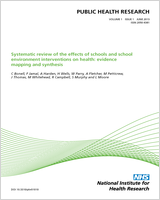Included under terms of UK Non-commercial Government License.
NCBI Bookshelf. A service of the National Library of Medicine, National Institutes of Health.
Bonell C, Dickson K, Hinds K, et al. The effects of Positive Youth Development interventions on substance use, violence and inequalities: systematic review of theories of change, processes and outcomes. Southampton (UK): NIHR Journals Library; 2016 May. (Public Health Research, No. 4.5.)

The effects of Positive Youth Development interventions on substance use, violence and inequalities: systematic review of theories of change, processes and outcomes.
Show detailsCB: process synthesis coding template
- 1.
Staffing continuity/quality/communication key to model
- Lack of opportunities for intersite communication surmountable challenge
- Staff retention challenging
- – Limited hours a surmountable challenge
- – Limited retention could lead to more poorly trained staff
- – Retention could lead to failure of sustained relationships
- – Retention aided by high salaries
- Good leadership particularly key
- Some programs required 24-hour worker availability but challenging
- Difficulty having staff expertise across a range of areas
- – Lack of training in some areas a surmountable challenge
- – But not always surmountable
- 2.
Community integration critical for implementation.
- Importance of outreach to key community members and parents
- Ethnicity and language critical for implementation
- – Recruit community members as staff
- – But volunteer staff not always reliable
- Importance of community generating ideas
- Parents feeling threatened by programme was barrier to uptake
- Community needs
- – Need for childcare/support key determinant of uptake
- 3.
Collaboration with other community agencies
- Collaboration can include community funders
- Collaboration can include other providers or services
- Collaboration with schools critical
- – For recruitment: importance of single point of liaison with schools
- – For activities
- 4.
Young people empowered to determine activities
- Recipients reject some components
- Reject components focused on problems of potential
- Reject uninteresting components
- Some components actually alienating to some young people
- Some based on pragmatism rather than empowerment
- Young people’s choices could cause problems
- – But this moderated by site mix at outset
- – But financial incentives to ensure participation in key activities
- Young people choosing mentors may increase success
- Not all programmes enabled empowerment
- 5.
Community can become topic of action
- 6.
Recipient behaviour/relationships did not derail PYD
- [In well-run sites] Poor recipient behaviour did not distract staff from PYD model
- Group differences not barrier to collaboration (as long as well-run site)
- –Different young people required different styles
- 7.
Determinants of fidelity
- Fidelity compromised where sites merely relabelled existing services
- Fidelity strengthened by affinity with prior work
- 8.
Sustained relationships also compromised by yp mobility
- 9.
But staff in some sites worked hard to retain recipients
- 10.
Pattern of provision reflected yp needs
- 11.
Intensity requirement causing perverse effects.
KD: process synthesis coding template
- 12.
Community-based relationships to enhance implementation and young people’s engagement
- Cultural relevance and integration to support implementation
- Local community member to enhance implementation and young people’s engagement
- Utilising local resources
- Local collaborations
- Consultation with the community
- Crossing language barriers
- Parental co-operation
- 13.
Communication and co-located After School sites
- Informal meetings, communicate and share experience
- School liaison
- Communication of programme goals
- 14.
Staffing issues
- Difficulty hiring PT staff in after-school settings
- Lack of training and utilising staff skill set
- Hiring and staff turnover
- Training and staff turnover
- Salary and staff retention
- Staff stability
- Engaged and unengaged staff
- Management turnover and leadership issues
- 24/7 ‘on call’ burn-out
- 15.
Youth–Staff relationships
- Staff as role models
- Youth-centred approach
- Qualities and features ‘valued’ or ‘desired’ in the relationship
- Relationship compromised by youth geographical movement
- Building on staff interests to re-engage youth
- 16.
Peer-to-peer relationships
- Overcoming differences
- Bonding/friendships
- 17.
Funding
- Sufficient funding
- Grant
- Long-term state investment
- Stipend to increase engagement
- 18.
Case management
- Problem-focused
- 19.
Youth led components
- Activities
- Research topics reflecting personal social experience
- Choosing mentors
- 20.
Programme dose/intensity/implementation levels
- Student attendance and outcomes
- 21.
Fidelity
- Variation in fidelity depending on existing programmes
- 22.
Flexible services
- Based on individual needs
- Challenges/difficulties: ‘hours target’
- Based on age group
- Process studies: coding templates - The effects of Positive Youth Development in...Process studies: coding templates - The effects of Positive Youth Development interventions on substance use, violence and inequalities: systematic review of theories of change, processes and outcomes
Your browsing activity is empty.
Activity recording is turned off.
See more...